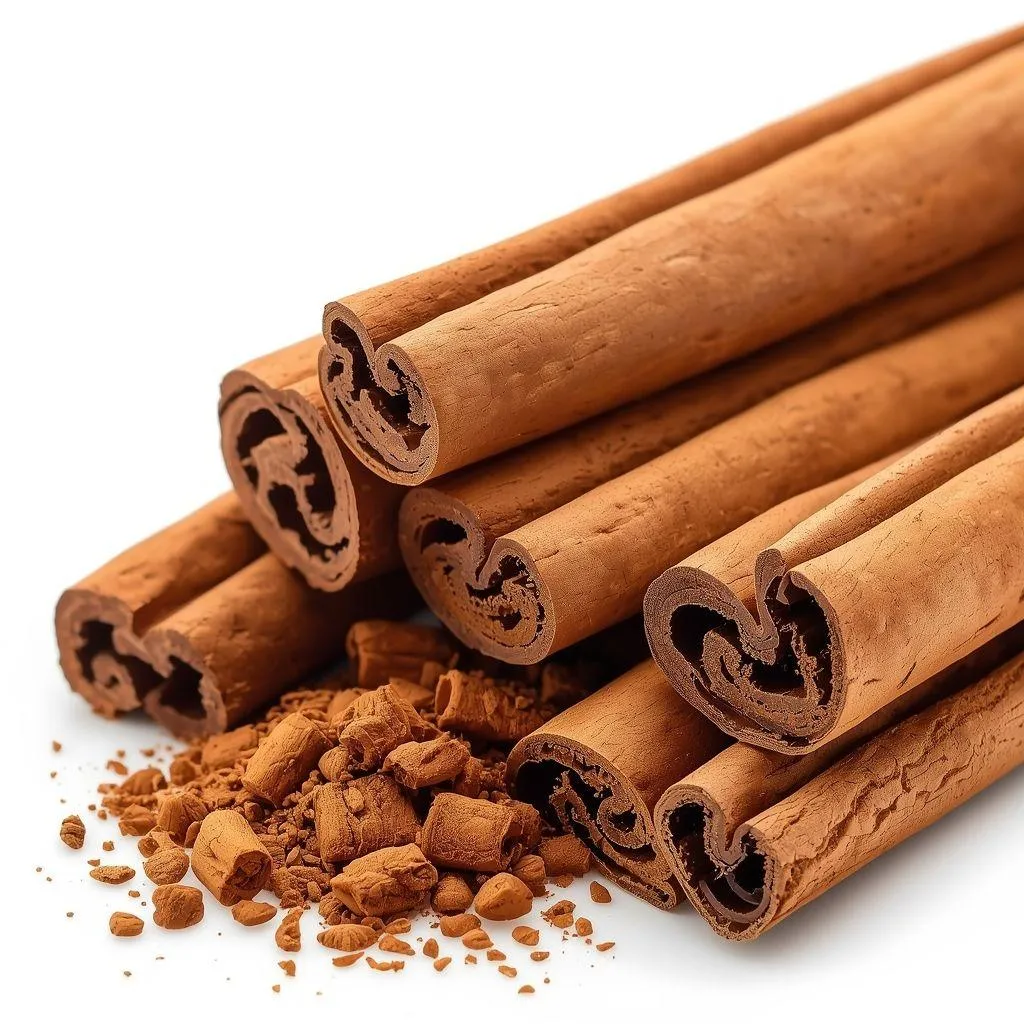- Max Müller
- October 23, 2025
- 18min.
- Report
Cinnamon Spice - Origin, Varieties, Nutritional and Health Benefits, Weight Reduction, Contraindications
Cinnamon has been one of the most popular culinary spices for years, mainly derived from the dried bark of the Ceylon cinnamon tree. It can be found in the form of an aromatic, rustic ground powder or as sticks rolled into a roll [2].
Table of Contents
1. What is cinnamon?
In fact, cinnamon was not merely utilized as a culinary spice, but also as a medicinal remedy. It was employed from the beginning in Ayurvedic and Chinese medicine. It was used to treat urinary tract infections, rheumatism, dizziness, toothaches, and even acne or impotence [3]. Our grandmothers also used it as an antidote for various ailments such as stomach aches, nausea, and vomiting. It turns out that they did not do so entirely by chance. With the progression of science and medicine, more researchers have become interested in this widely used and intriguing spice. Over time, it has been demonstrated to possess numerous antibacterial, antifungal, therapeutic, metabolism-supporting, and weight loss-promoting properties. The popularity of cinnamon has also led to its increased incorporation into various food products such as chocolates, beverages, desserts, alcohol, and many others. The FDA (Food and Drug Administration) has recognized cinnamon as generally safe and granted it GRAS status [3]. Unfortunately, it has been discovered that this product also has its drawbacks and is not recommended for everyone [2].2. Emergence and varieties of cinnamon
There are no exact records regarding the discovery of cinnamon. However, cinnamon has been known since ancient times. Evidence suggests that it was used in Egypt for the mummification of bodies. Cinnamon trees are trees of varying heights with leathery, oval leaves and yellow-green flowers. Their fruits are drupes or berries with a wide range of colors. Cinnamon belongs to the Lauraceae family and has over 250 species. Only two types of cinnamon are found in the market: Ceylon cinnamon (lat. Cinnamomum zeylanicum) and Chinese cinnamon (lat. Cinnamomum cassia). Ceylon cinnamon is available on the island of Sri Lanka and in South America, Southeast Asia, and the Caribbean. Cassia, on the other hand, is found in the areas of Vietnam, Burma, and China. Ceylon cinnamon in the form of bark curls up from both sides and takes the form of a double pipe. In cross-section, it looks like a cigar made up of thin sheets. Cassia, on the other hand, has smooth, single, and gently rolled bark pieces. The ground form of both types differs in color. Ceylon cinnamon has a light, yellowish-brown color, while Chinese cinnamon is dark red or reddish-brown. The taste of both varieties is completely different. Ceylon cinnamon is mild, spicy, and slightly sweet. Cassia has a burning and bitter taste.3. What nutritional components are present in cinnamon?
Cinnamon is a spice that delivers up to 247 kcal in 100 g to the body. Its main components are carbohydrates and fiber, 81 g and 53 g respectively. It practically does not contain fat, in 100 g of the product it is only 1.2 g, of which trans fatty acids do not exist at all, as well as cholesterol. Protein also occurs in small quantities, only 4 g. However, there are many vitamins and minerals. Cinnamon is a good source of potassium – 431 mg, calcium – 1002 IU and 295 IU carotenoids. The most important ingredients that can be found in the bark of this plant are cinnamaldehyde, alcohol, phenolic acids, terpenes, fiber, tannins and coumarins.4. The influence of cinnamon on our wellbeing
In recent years, numerous studies have been conducted to investigate the impact of cinnamon consumption on our health. The majority of scientific evidence concerns the positive effects of this spice on heart disease and type 2 diabetes. Cardiovascular diseases are currently a serious health issue worldwide. In 2012, a total of 17.5 million people died from cardiovascular diseases, with the most common cause being a stroke or coronary heart disease. Scientists have begun to take note of the health benefits of a healthy diet and the reduction of the risk of death from cardiovascular diseases. In this context, the positive impact of cinnamon on health issues related to the cardiovascular system is increasingly being observed. Currently, there are many scientific evidence that confirm the positive impact of cinnamon on health [4]. In one experiment on rats, where hypertension was induced by administering methyl ester of L-Nitroarginin, also known as L-NAME (N (G)-Nitro-L-arginine methyl ester), they began to be given an extract from cinnamon in a dose of 5, 10 or 20 mg per kilogram of body weight. After some time, a decrease in blood pressure of 12.5; 26.6 and 30.6% was observed in the rats. Interestingly, in the same study, the animals were given the same extract, but in a dose of 300 mg per kilogram of body weight per day. Then, an improvement in the lipid profile of the rats was observed. The concentration of triglycerides in the blood plasma decreased by about 38.1%, the total cholesterol level by 32.1%, and the LDL level even by 75.3%. At the same time, the HDL level increased by 58.4%. It was also observed that in rats receiving cinnamon extract, the atherogenicity index decreased [4]. In another study on rats with hypertension conducted by another team, it was observed that in representatives of this species that were on a sugar-rich diet, significantly higher levels of systolic blood pressure were recorded than in these animals that additionally consumed cinnamon in an amount of 2 or 6% [4].5. Is cinnamon truly beneficial for the reduction of excess body mass?
In the internet and on television, it is constantly repeated that cinnamon is one of many wonderful spices that allows you to easily get rid of excess kilograms. Unfortunately, there are no studies that would confirm these reports. Possibly, the people promoting this dietary myth based their claims on research indicating the sensitivity of tissues to insulin through the use of this spice. Reducing the level of sugar in the blood indeed helps in weight reduction, but no spectacular results should be expected. Others emphasize that cinnamon contains fiber, which also positively affects digestion and supports the fight against overweight. Unfortunately, a teaspoon of ground spice contains a little over 1 gram of fiber per 2 grams of sugar [11]. Therefore, there is no reason to consider this as a quick solution. So far, no miraculous substance has been found that would help maintain a slim figure without sacrificing anything. The only thing you can be sure of is that a balanced diet and regular physical activity are key.6. Contraindications for the use of cinnamon
Regrettably, cinnamon, due to its potent allergenic properties, is not a recommended spice for everyone. Its consumption by an individual with an allergy or hypersensitivity may result in mild skin or abdominal pain symptoms and can even lead to a life-threatening anaphylactic reaction. Additionally, cinnamon is a cross-reactive allergen [6]. Indeed, the primary cause of allergies to all spices, including the one discussed, is the presence of cross-allergy, which is akin to allergens of various origins. A cinnamon allergy or hypersensitivity most frequently affects individuals who also have allergies to grass pollen or other dietary components, such as nutmeg, pepper, paprika, and ginger [6]. Other contraindications for cinnamon use stem from varying opinions regarding coumarin. Despite a lack of precise studies confirming its detrimental effects on humans, the European Union has imposed a limit on all food products that include the aforementioned spice – coumarin must not exceed 50 mg per kilogram of manufactured food [1].7. Is it genuinely advantageous to incorporate cinnamon into your culinary offerings?
If we display no indications of hypersensitivity or cinnamon allergy, we can derive benefits from its numerous advantages. Not only will it enhance the flavor of our meals, but it will also aid, due to its antibacterial properties, especially in the winter season, in bolstering the body's immune system and expediting recovery in the event of sickness. Moreover, the phenolic acid present in cinnamon will reinforce our entire immune system, providing protection against the development of cancer, and the extracts of this exceptional spice will fortify our blood system.
Latest Diets

Express Shape - 1600 kcal protein diet - 3 weeks of healthy weight loss

Instant Metamorphosis - 1600 kcal protein diet for 14 days

Revolution Week - 1600 kcal fast protein diet - 7 days of weight loss

Low Carb Challenge - 1600 kcal low-carb diet - 4 weeks of a lighter figure

Power Protein - high-protein slimming diet 1500 kcal - 4 weeks of energy and reduction

Sven's Plan - 1500 kcal diet - 4 weeks of healthy weight loss

Express diet 1300 kcal - quick reduction in 4 weeks according to Sven

Protein Fit - 1400 kcal protein diet - 4 weeks of weight loss step by step

Fit Figura - 1400 kcal slimming diet - healthy results in 4 weeks

Slim Plan 28 - 2000 kcal reduction diet - 28-day weight loss plan

Dream Shape - 1800 kcal weight loss diet - 4 weeks of lasting change

Protein Power 4 - 2200 kcal protein diet - 4 weeks of energy and reduction

